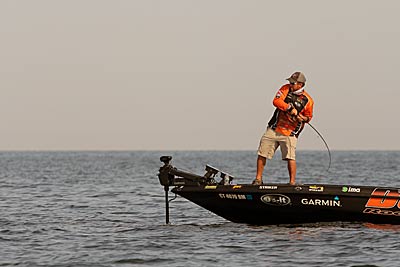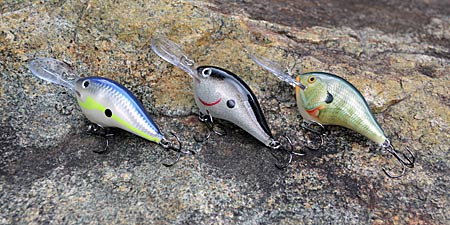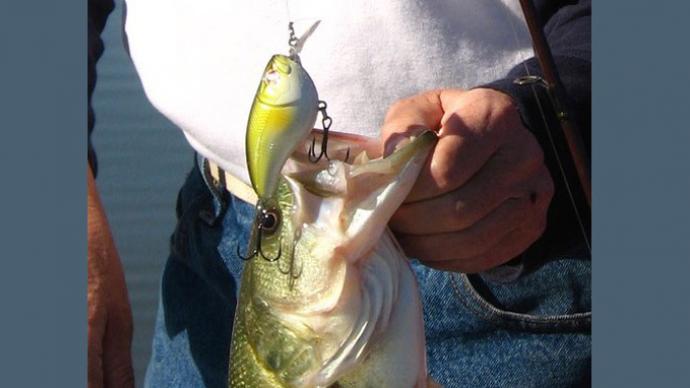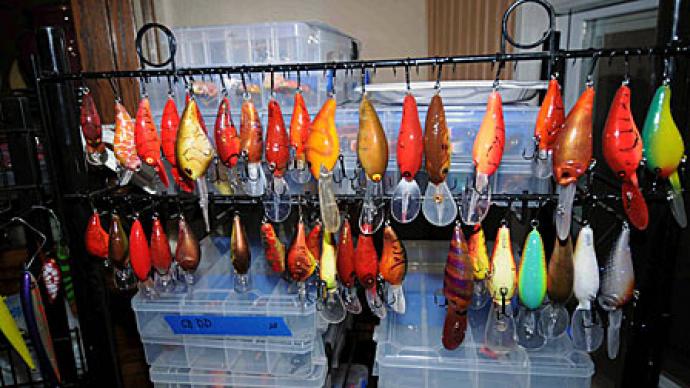
Selecting the best lure for the fishing situation that you’re facing can be a daunting task. First, it must fish the depth, cover, and structure where you found the bass. And its action and profile need to solicit strikes.
But that only gets you partway to your first cast. You still have to decide on the lure’s color. Millions of lures are built for bass fishing, and each seems to be available in a rainbow’s worth of colors, not including options from custom painters. With that dizzying amount of choices, it’s easy to spin out. But you don’t have to. There are methods to overcome this madness.
Most anglers follow one of two approaches to selecting a lure color. First, they stick with a favorite, the color that seems to produce for them wherever and whenever they are fishing. And there’s a lot to say about confidence in bass fishing. Many days, putting your head down and casting is enough to grind out plenty of bites. But what if that doesn’t work? Then, you move to approach No. 2.
Fish enough, and you’ll hear some basic “rules” for color selection, such as natural or translucent colors in clear water. Sticking to those is a good move. But they don’t explain the theory behind them. And if you understand that, you’ll be further ahead in the bass-fishing game.
Uncovering the theories behind lure color selection requires plenty of time on the water. Or, in this case, picking the brains of professional bass-tournament anglers who spend most of each year chasing bass from coast to coast. Four explained how they chose a color to start with, when, and why they changed it throughout a fishing day to keep the bass biting. It’s wise advice that will focus you on finding and catching bass, not digging through tackle boxes, and guessing which color of lure you should try next.
Keep It Simple
Custom-painted hard baits have a huge following. Many bass anglers find confidence in the ultra-realistic and unique schemes created with airbrushes. But don’t count Bassmaster Elite Series angler Paul Mueller among them. While he’s won, or nearly won, on various waters — Florida’s St. Johns River, Georgia’s Lake Lanier, and New York’s portion of Lake Ontario and St. Lawrence River — he limits his selection of lure colors to what manufacturers offer.
Image
Major League Fishing and Bass Pro Tour angler Dave Lefebre likes options, especially when fishing a crankbait. In summer, he wants one that imitates a shad or panfish. Different variations allow him to finetune his offering to the water color and bass activity. Photo by Pete M. Anderson Don’t take that as Mueller dismissing the importance of fishing the best color for the current conditions. At times, color makes a huge difference, he said. “But I try to simplify it,” he said. “Every angler is guilty of having more colors than they need.”
Narrowing your selection to a manageable size is all about managing distractions. Carry enough variety to match different conditions, but don’t include so many off-the-wall patterns that you’re tempted to rotate through them to generate bites. Most times, a change in location or presentation, such as retrieve speed, will net better results.
Fellow Bassmaster Elite Series angler Micah Frazier concurs, especially regarding soft-plastic lures. “I’ve always been simple about it,” he said. He estimates that he fishes a black with a blue flake or green pumpkin soft-plastic lure about 90% of the time. “There are times I have to dig in my extra stuff in the truck and grab something,” he said. Those occasions include switching to some version of watermelon with flake when the water is clear.
Consider Other Variables
Jay Yelas believes lure color is integral to the presentation that generates the most bites on a given day. But for this Bassmaster Elite Series angler, who counts Bassmaster Classic champion and Angler of the Year among his titles, it’s not as important as others. Instead, he wants to find the best lure and presentation first.
A crankbait of any color, as long as it’s fished at the correct depth and the right speed, will catch plenty of bass, Yelas said. Miss either, and you’ll be hauling water. But once he nails both, he experiments with color. Finding the best one often means more bites, he said.
Yelas doesn’t experiment with lure color much during tournament practice. He usually picks one that matches the conditions — a primary shad hue, for example, if the shad spawn is underway — and focuses on finding fish. He waits until the competition begins to make adjustments, such as selecting a shad pattern with a bit of chartreuse, to generate more bites as conditions change. “There are times when color makes a bigger difference,” he said. “When the rest is set, tinker with color.”
Water color also determines how Yelas chooses a lure color. He said any color will work in stained or muddy water. There, bass feed on sounds and vibrations, thanks to their super-tuned lateral line. But when the water is clear, sight plays a bigger role. Then, he wants a translucent color that blends into the background, so the bass must bite to ascertain if it’s food.
Match The Hatch
Mueller is no stranger to fishing clear water, which gives bass an advantage. “They can see more than you want them to see,” he said. So, he also transitions to lures in more natural and translucent colors, too. Some days, he’ll go as far as colorless. “I’ll do that with spybaits, jerkbaits, crankbaits, topwaters — you name it,” he said. “On those calm days, when the sun is bright, and water is clear, a translucent spy bait will make you forget how tough the fishing is.”
Windy or overcast days demand solid colors such as gold and white. Mueller said they are easily seen underwater in low-light conditions caused by clouds and waves. He adds chartreuse and bubble gum to this list with an asterisk: Both catch smallmouth in clear water on bright days, too.
Image
Consider the water color when choosing a soft-plastic lure. Solid colors, such as black and blue, show better in dirty water. In clear water, bass feed by sight and use translucent colors such as watermelon. They are harder to see, encouraging bass to bite them to ascertain if it’s food. Photo by Pete M. Anderson Sky conditions and water color aren’t the only variables that Mueller considers when choosing a lure color. “You want [a lure] that matches the bottom, too,” he said. Walk the bank or wade shallow water, and you’ll notice minnows are a natural sandy color. He said little sunfish, which hide among rocks in shallow water, often appear black or green pumpkin. That’s most likely why if you polled Elite Series anglers on the best all-around color. He wouldn’t be surprised if almost all pointed to watermelon or green pumpkin, the latter a powerful fish producer in clear and dirty water.
Regardless of water clarity, Mueller makes sure his color choice fits where he is fishing. “The first thing [to consider when choosing a lure color] is forage,” he said. “What are they eating? If you can match [that], you will master the game.” In the waters of his home state — Connecticut — bass key off four types of forage: yellow perch, alewives, bluegills or sunfish, and crawfish. “What does each look like — that is what you want to mimic,” he said.
While some species of crawfish in the South turn red in spring — making red lures a popular choice there — the ones in Mueller’s neck of the woods rotate through other colors, from maroon, brown, and dark green in spring to a light brown in summer to dark brown, sometimes with a hint of red, in fall. So, when fishing lures imitate them, he changes colors with the season.
It’s a similar deal with yellow perch, another smallmouth favorite. Connecticut’s Candlewood Lake, for example, has slightly stained water. Mueller said that turns its yellow perch a vibrant yellow, making chartreuse with black back crankbaits and jerkbaits good choices. “With moving lures, just get the basic colors,” he said. “There’s no need to put a fine point on the details.”
Head north and slightly west to Lake Champlain, which follows the Vermont-New York line, and the situation is reversed. Mueller said its gin-clear water makes yellow perch look washed out. So, he said, a jerkbait sporting a realistic perch pattern gets the most strikes.
Resuscitate Slowing Bites
Major League Fishing and Bass Pro Tour angler Dave Lefebre also believes in matching the hatch. And when the calendar turns to summer, he keeps up by switching his lure colors, especially when it comes to crankbaits. “It’s always going to be that shad look first,” he said. That also mimics small crappie and bluegills, which big bass eat.
With a wide selection of colors within the shad category, Lefebre looks toward the water color to find his choice. If the water is clear, he wants a subtle version. If it’s dirty, he’ll tie on something louder, such as Rapala’s Helsinki shad, which sports a splash of chartreuse. “White glows in muddy water,” he said. He’ll even throw one in firetiger, which he sees as part of the shad spectrum.
While that approach serves Lefebre well day in and day out, there are times when he needs to go a step further, such as when fishing a school of bass on a deep point or river channel ledge. While his usual choice for the water conditions will generate plenty of bites, he said the bass eventually will become “bored” with his crankbait. But they will react to the same lure in a different color. “I like to have every color available,” he said. “That one more bite you get could be an 8-pounder.”




